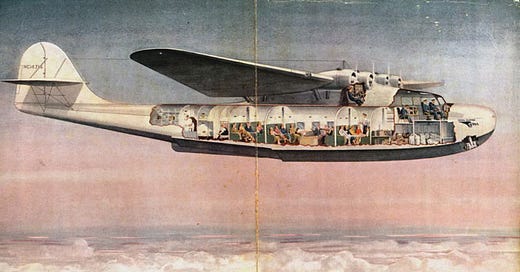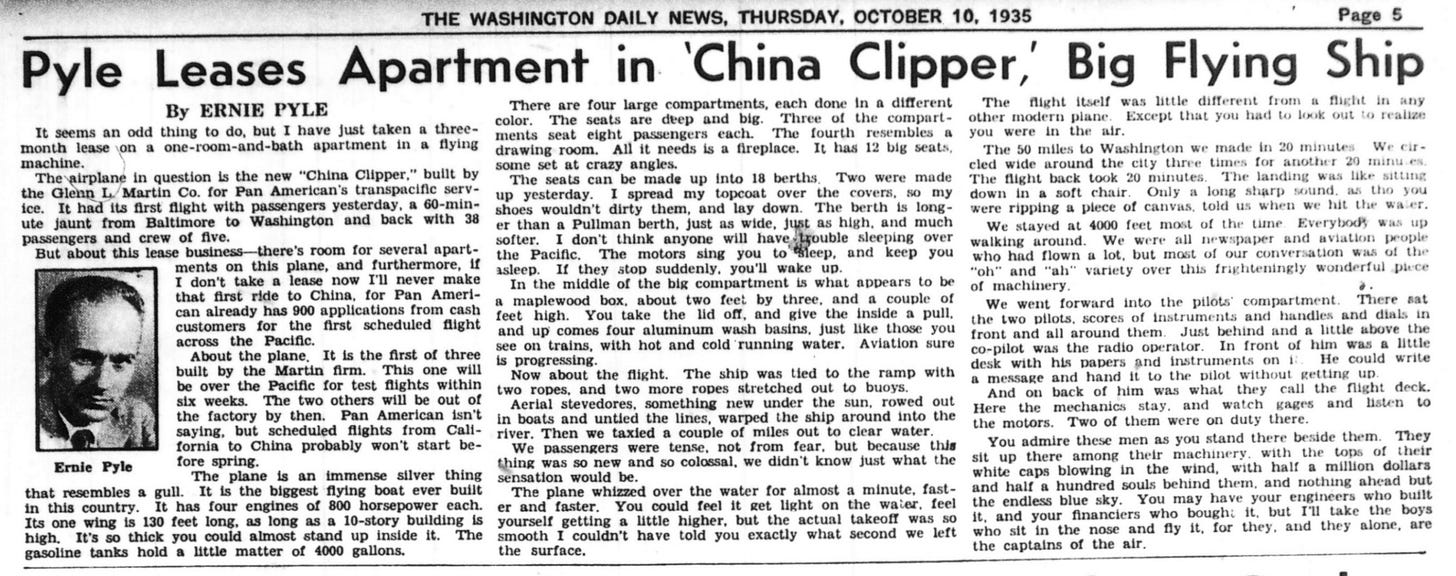THE WASHINGTON DAILY NEWS — THURSDAY, OCTOBER 10, 1935
Pyle Leases Apartment in ‘China Clipper,’ Big Flying Ship
By ERNIE PYLE
It seems an odd thing to do, but I have just taken a three-month lease on a one-room-and-bath apartment in a flying machine.
The airplane in question is the new “China Clipper,” built by the Glenn L. Martin Co. for Pan American’s transpacific service. It had its first flight with passengers yesterday, a 60-minute jaunt from Baltimore to Washington and back with 38 passengers and crew of five.
But about this lease business—there’s room for several apartments on this plane, and furthermore, if I don’t take a lease now I’ll never make that first ride to China, for Pan American already has 900 applications from cash customers for the first scheduled flight across the Pacific.
About the plane. It is the first of three built by the Martin firm. This one will be over the Pacific for test flights within six weeks. The two others will be out of the factory by then. Pan American isn’t saying, but scheduled flights from California to China probably won’t start before spring.
The plane is an immense silver thing that resembles a gull. It is the biggest flying boat ever built in this country. It has four engines of 800 horsepower each. Its one wing is 130 feet long, as long as a 10-story building is high. It’s so thick you could almost stand up inside it. The gasoline tanks hold a little matter of 4000 gallons.
There are four large compartments, each done in a different color. The seats are deep and big. Three of the compartments seat eight passengers each. The fourth resembles a drawing room. All it needs is a fireplace. It has 12 big seats, some set at crazy angles.
The seats can be made up into 18 berths. Two were made up yesterday. I spread my topcoat over the covers, so my shoes wouldn’t dirty them, and I lay down. The berth is longer than a Pullman berth, just as wide, just as high, and much softer. I don’t think anyone will have trouble sleeping over the Pacific. The motors sing you to sleep, and keep you asleep. If they stop suddenly, you’ll wake up.
In the middle of the big compartment is what appears to be a maplewood box, about two feet by three, and a couple of feet high. You take the lid off, and give the inside a pull, and up comes four aluminum wash basins, just like those you see on trains, with hot and cold running water. Aviation sure is progressing.
Now about the flight. The ship was tied to the ramp with two ropes, and two more ropes stretched out to buoys. Aerial stevedores, something new under the sun, rowed out in boats and untied the lines, and warped the ship around into the river. Then we taxied a couple of miles out to clear water.
We passengers were tense, not from fear, but because this thing was so new and so colossal, we didn’t know just what the sensation would be.
The plane whizzed over the water for almost a minute, faster and faster. You could feel it get light on the water, feel yourself getting a little higher, but the actual takeoff was so smooth I couldn’t have told you exactly what second we left the surface.
The flight itself was little different from a flight in any other modern airplane. Except that you had to look out to realize you were in the air.
The 50 miles to Washington we made in 20 minutes. We circled wide around the city three times for another 20 minutes. The flight back took 20 minutes. The landing was like sitting down in a soft chair. Only a long sharp sound, as tho you were ripping a piece of canvas, told us when we hit the water.
We stayed at 4000 feet most of the time. Everybody was up walking around. We were all newspaper and aviation people who had flown a lot, but most of our conversation was of the “oh” and “ah” variety over this frighteningly wonderful piece of machinery.
We went forward into the pilots’ compartment. There sat the two pilots, scores of instruments and handles and dials in front and all around them. Just behind and a little above the co-pilot was the radio operator. In front of him was a little desk with his papers and instruments on it. He could write a message and hand it to the pilot without getting up.
And on back of him was what they call the flight deck. Here the mechanics stay, and watch gages and listen to the motors. Two of them were on duty there.
You admire these men as you stand there beside them. They sit up there among their machinery, with the tops of their white caps blowing in the wind, with half a million dollars and the endless blue sky behind them, and nothing ahead but water. You may have your engineers who built it, and the financiers who bought it, but I’ll take the boys who sit in the nose and fly it, for they, and they alone, are the captains of the air.
💛 **Enjoyed this post?** Your support helps us continue to transcribe and promote Ernie’s work. Please click the link below to donate.





